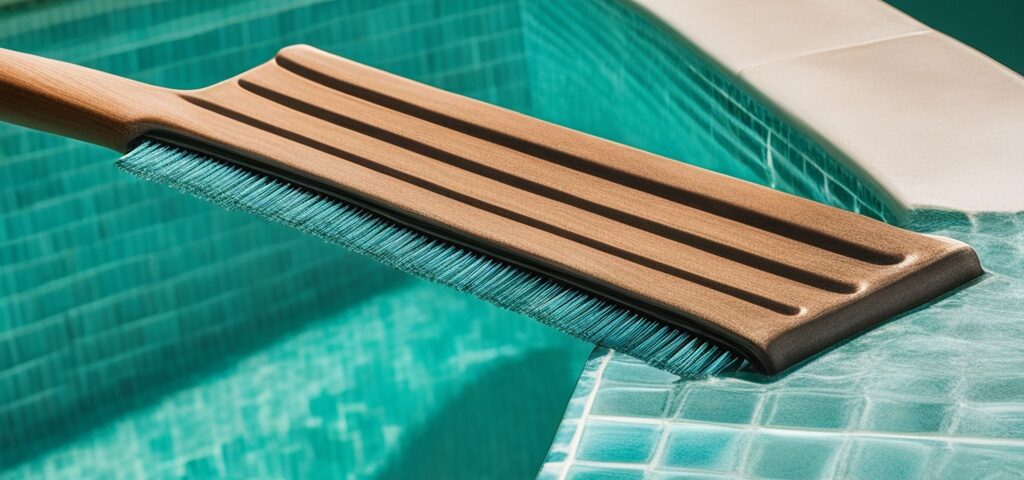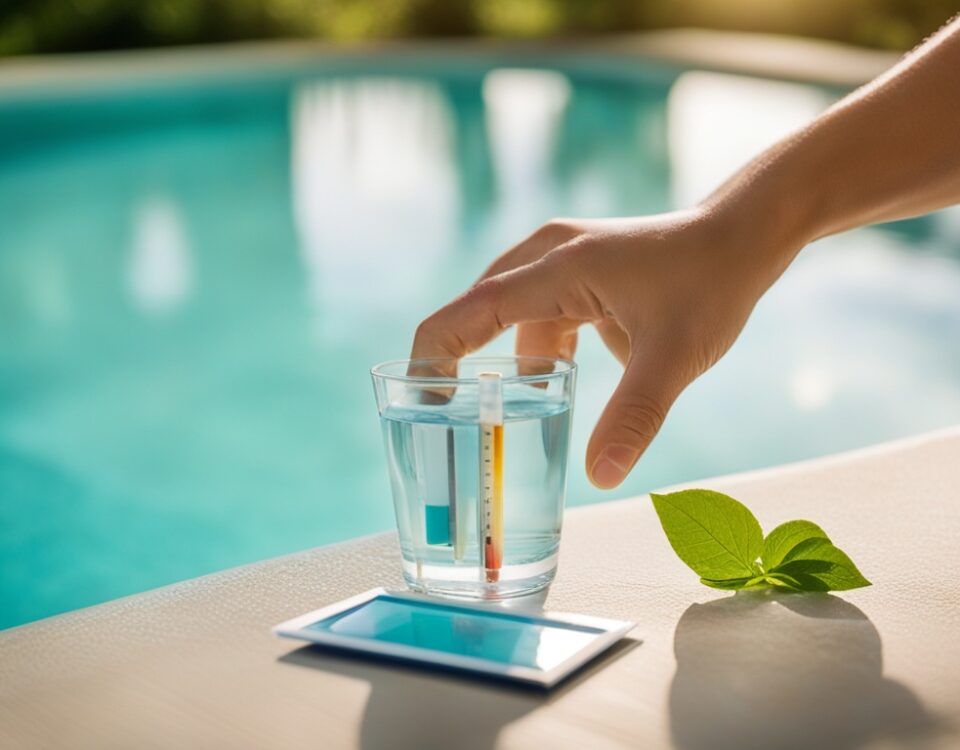Sparkling Secrets: Transform Your Pool with Expert Tile Cleaning Tips!

Master Your Oasis: Essential Pool Maintenance Checklist
May 10, 2025
Unveiling the True Concrete Pool Cost: Let’s Dive into Transparency
May 11, 2025Understanding the Importance of Clean Pool Tiles
The clarity and quality of your swimming pool water hinges significantly on the condition of the pool tiles. Over time, tiles can accumulate grime, calcium deposits, and algae, which not only degrade the visual aesthetic of your oasis but also critically influence the water quality. *Dirty pool tiles are not merely an eyesore; they can be a breeding ground for harmful bacteria and microorganisms*, compromising the safety of swimmers and potentially resulting in costly maintenance issues.
The Aesthetic Impact
First impressions matter, and your pool area is no exception. *Dirty, stained, or discolored tiles can detract from the overall beauty of your pool*. Clean tiles contribute to a sparkling appearance, making your pool inviting for family and guests alike. Regular maintenance ensures that your pool maintains a tranquil and appealing environment, reinforcing its status as a highlight of your property.
Water Quality Considerations
A pristine pool is synonymous with clean water. When tiles are neglected, contaminants can fester, leading to cloudy water and unpleasant odors. *Algae and bacteria thrive in unclean conditions*, requiring a more intensive and often expensive cleaning regimen. By ensuring your tiles are frequently cleaned, *you can maintain a healthier pool environment*, which will subsequently lead to a more enjoyable swimming experience.
Preventing Algae Growth
One of the most insidious problems for pool tile cleanliness is algae growth. Algae can cling stubbornly to pool surfaces, and once established, *it can become extremely challenging to eradicate*. Regular cleaning helps to disrupt the growth cycle of algae, reducing the need for harsh chemicals and extensive scrubbing later on. With proactive measures in place, *the likelihood of a significant algae outbreak diminishes dramatically*.
Extending the Lifespan of Your Pool
Maintaining clean tiles does more than improve aesthetics and water quality; it can also prolong the lifespan of your pool. *Corrosion and deterioration from mineral buildup may lead to cracks and leaks over time*. By engaging in routine tile cleaning, you protect the structural integrity of your pool, which can save you from costly repairs in the future. *Investing time in regular maintenance is an investment in your pool’s longevity*.
Cost-Efficiency in Maintenance
Many pool owners overlook the long-term financial benefits of clean tiles. While a thorough cleaning may require upfront effort or expense, the resultant *reduced need for chemical treatments*, coupled with the avoidance of extensive repairs, translates into cost savings over time. *A well-maintained pool is far more economical than one that requires constant major interventions due to neglect*.
Gathering the Necessary Supplies
Cleaning pool tiles requires a few essential supplies to ensure the task is not only effective but also safe. The first item on your checklist should be a *high-quality pool tile cleaner*. These specialized cleaners are formulated to break down stubborn dirt, mineral deposits, and calcium buildup that can accumulate on your tiles over time. Opt for ones that are specifically designed for the types of tiles in your pool to avoid damaging them.
Essential Cleaning Tools
In addition to a reliable tile cleaner, a durable scrub brush with stiff bristles is crucial for the scrubbing process. Look for brushes with long handles to facilitate reaching difficult areas without straining yourself. Pairing the scrub brush with a pool vacuum or automatic tile cleaner can further enhance your cleaning efficiency, especially if your pool tiles have accumulated significant grime.
Personal Protective Equipment
When embarking on your cleaning venture, safety should be a top priority. This means arming yourself with the right protective gear. *Safety goggles* will protect your eyes from splashes of cleaning solution, while gloves will safeguard your skin from harsh chemicals. Investing in high-quality gloves not only ensures protection but also provides a better grip when handling cleaning tools.
Where to Purchase Supplies
Finding these supplies is straightforward. Local pool supply stores often stock an array of cleaning products and tools tailored to your pool’s specific needs. Additionally, large home improvement chains and online retailers offer convenience and competitive pricing. Shopping online, whether through Amazon or specialty pool sites, allows you to read customer reviews and compare products easily.
Eco-Friendly Options
For environmentally conscious readers, there are numerous eco-friendly pool tile cleaning options available. Look for biodegradable cleaners that are effective yet gentle on the environment. Many brands now produce plant-based cleaning products that avoid harsh chemicals, making them safer for both the user and surrounding wildlife. Examples include vinegar-based cleaners or those that feature natural abrasives like baking soda.
Cost-Effective Alternatives
Should you wish to save on costs, consider exploring DIY cleaning solutions. A mixture of *baking soda* and water can work wonders in scrubbing away light stains, while *white vinegar* serves as a natural disinfectant and degreaser. These ingredients can often be found in your kitchen, further promoting a sustainable approach to pool maintenance.
Preparing the Pool Area
Before embarking on the sometimes daunting task of cleaning your pool tiles, it is imperative to *adequately prepare the pool area*. This initial step not only ensures your safety but also enhances the effectiveness of the cleaning process. Here’s a meticulous guide to help you navigate through this essential phase.
Safely Draining the Pool Water
To begin with, you need to drain the pool water to a suitable level, typically about 4 to 6 inches below the tiles. This level will expose more surface area for effective cleaning while preventing water from interfering with your task. First, turn off the pool pump and ensure it’s disconnected to avoid any accidents.
Using a submersible pump, connect the hose securely to allow for controlled drainage. As you set the pump in the shallow end of the pool, ensure that it is positioned correctly to maximize efficiency. Depending on the size of your pool, this process may take some time; thus, patience is essential. Remember to check local regulations regarding discharging pool water, as improper disposal can have environmental implications.
Removing Debris and Floating Objects
As you drain the pool, take this opportunity to collect any debris or floating objects. Using a long-handled net or skimmer, systematically remove leaves, insects, and other contaminants from the surface of the water. This is crucial, as unwanted materials can lead to *contamination* during tile cleaning.
Additionally, consider employing a vacuum specifically designed for pools to address any stubborn particulates resting on the bottom. Make sure to navigate the vacuum slowly over the surface to ensure comprehensive debris collection while minimizing disturbances. This preparatory phase is essential to enhance the overall cleanliness and hygiene of your pool.
| Debris Type | Recommended Removal Method |
|---|---|
| Leaves | Use a Skimmer Net |
| Insects | Use a Skimmer Net |
| Dust and Sand | Vacuum the Pool Floor |
| Algae Blooms | Vacuum and Use Pool Chemicals |
With the water drained and the pool free of debris, you create a conducive environment for effectively cleaning the tiles. Ensuring that the area is prepped in this manner not only safeguards your well-being during the process but also streamlines your cleaning efforts, contributing to a sparkling and inviting pool ambiance.
Choosing the Right Cleaning Method
Hand Scrubbing: A Traditional Approach
When it comes to cleaning pool tiles, hand scrubbing remains a tried-and-true method. Utilizing a stiff brush along with a suitable cleaning solution, this approach allows for precise targeting of dirt and grime. However, the pros and cons must be weighed carefully.
Pros: Hand scrubbing is cost-effective, requiring only minimal supplies such as a brush and cleaning agents. It also permits access to hard-to-reach areas and enables the cleaner to control the pressure applied, thus reducing the likelihood of damaging the tile surface.
Cons: This method can be time-consuming, especially for larger pools, and may lead to fatigue if not done in moderation.
Pressure Washing: Efficiency with Caution
Pressure washing is another popular alternative, utilizing concentrated water jets to remove stubborn stains and buildup effortlessly. This method significantly reduces the labor involved in cleaning.
Pros: Pressure washers can efficiently cover large surface areas, saving both time and energy. They are highly effective against algae, calcium deposits, and other tough stains.
Cons: However, caution is necessary; excessive pressure can damage grout or crack tiles. Additionally, hiring equipment can escalate costs, especially for infrequent use.
Professional Pool Tile Cleaners: The Hassle-Free Option
For those seeking a no-fuss solution, hiring professional pool tile cleaners is an advantageous choice. These experts come equipped with specialized tools and experience that ensure effective cleaning.
Pros: Professionals save you time and physical exertion, offering a thorough clean with the right expertise. Their use of advanced techniques minimizes the risk of damage.
Cons: On the flip side, this method comes at a higher financial cost, and scheduling visits may be inconvenient depending on your availability.
Comparative Overview
| Cleaning Method | Cost | Time Efficiency | Effectiveness |
|---|---|---|---|
| Hand Scrubbing | Low | Low | Moderate |
| Pressure Washing | Moderate to High | High | High |
| Professional Cleaning | High | Very High | Very High |
Conclusion: Your Pool, Your Choice
Deciding on the right cleaning method for your pool tiles is a matter of personal preference, budget constraints, and time availability. By carefully weighing the pros and cons of each approach—hand scrubbing, pressure washing, or hiring professionals—you can ensure your pool remains a pristine oasis for relaxation and enjoyment.
Step-by-Step Cleaning Process
Cleaning your pool tiles is a vital maintenance task that not only enhances the aesthetic appeal of your pool but also prevents more significant issues such as algae growth and mineral buildup. Follow this step-by-step cleaning process to ensure your tiles remain sparkling clean and free of harmful deposits.
1. Apply the Pool Tile Cleaner
The first step in your cleaning endeavor is to select an effective pool tile cleaner. Whether you opt for a commercial product or a natural alternative, ensure it is suitable for your tile type. To apply the cleaner, follow these steps:
- Read the instructions on the product label to determine the appropriate dilution ratio, if necessary.
- Using a spray bottle or a clean sponge, liberally apply the cleaner to the affected tile surfaces, concentrating on areas with noticeable stains or buildup.
- Allow the cleaner to sit for the recommended time to break down grime effectively.
2. Scrubbing the Tiles
Once the cleaner has had sufficient time to work its magic, it’s time to scrub. Use a non-abrasive brush or a scrub pad designed for pool surfaces:
- Begin scrubbing in a circular motion to loosen dirt and grime without damaging the tile.
- Focus on corners and crevices, where debris tends to accumulate.
- For large areas, consider dividing the pool into sections to ensure a thorough clean.
3. Rinse with Clean Water
After scrubbing, it is essential to rinse the tiles thoroughly:
- Use a garden hose or a pressure washer set to a low setting to remove all traces of cleaner and loosened dirt.
- Ensure that all residues are washed away to prevent any chemical reactions that might cloud your pool water.
4. Tackling Stubborn Stains and Mineral Deposits
Occasionally, you may encounter stubborn stains or mineral deposits that require extra effort:
- For tough stains, create a paste using baking soda and water. Apply it to the stain, let it sit for 10-15 minutes, then scrub gently.
- If mineral deposits persist, consider using a diluted solution of muriatic acid with caution. Follow safety guidelines, and ensure adequate ventilation.
- A pool tile brush specifically designed for tough jobs can be a great investment for dealing with recurring issues.
5. Regular Maintenance Tips
To keep your pool tiles looking pristine, incorporate these maintenance tips into your routine:
- Brush your pool tiles at least once a week to prevent buildup.
- Test your pool water regularly to maintain balanced pH levels, which can reduce staining.
- Consider investing in a pool cover to limit debris accumulation when the pool is not in use.
6. Essential Tools and Products
| Tool/Product | Purpose |
|---|---|
| Non-Abrasive Brush | For scrubbing tiles without scratching |
| Pool Tile Cleaner | To dissolve dirt and stains |
| Baking Soda | For creating a natural cleaning paste |
| Muriatic Acid | For tough mineral deposits (use with caution) |
Maintaining Clean Pool Tiles
To uphold the pristine allure of your swimming pool and ensure the longevity of your tiles, regular maintenance is essential. Establishing a routine that embraces both cleaning and preventative measures will guard against the dreaded build-up of grime, scale, and organic matter that can mar your oasis. Here, we explore effective practices that will help you maintain impeccable pool tiles, ensuring they sparkle season after season.
Establishing a Cleaning Routine
A critical aspect of tile maintenance lies in developing a consistent cleaning regimen. Aim to skim the surface of your pool at least once a week to remove debris that can settle on the tiles, leading to stains and build-up. Additionally, employing a soft brush specifically designed for pool surfaces will allow you to gently scrub the tiles during your weekly maintenance, dislodging any lingering dirt or algae without causing damage. Remember, prevention is far simpler than remediation; addressing any accumulating grime promptly will extend the lifespan of your tiles considerably.
Utilizing the Right Cleaning Solutions
While some may be tempted to resort to harsh chemical cleaners, opting for gentle, pH-balanced solutions is advisable to preserve the integrity of your tiles. Consider utilizing a mixture of *white vinegar* and *baking soda*—a potent yet natural combination that cuts through dirt without eroding the surface. Regular application of this eco-friendly solution not only assists in maintaining a crystal-clear appearance but also significantly reduces the risk of future build-up.
Creating a Schedule for Routine Inspections
In addition to regular cleaning, scheduling quarterly inspections should become a non-negotiable part of your pool maintenance plan. During these inspections, assess the condition of your tiles for any signs of *cracking*, *chipping*, or *loose tiles*. Addressing these minor repairs promptly can preempt larger, costlier issues down the line. Keeping a log of your inspections and any maintenance tasks performed can also prove beneficial, allowing you to monitor the condition of your tiles over time.
| Maintenance Task | Frequency |
|---|---|
| Skimming Pool Surface | Weekly |
| Tile Brushing | Weekly |
| Complete Cleaning with Solution | Bi-Weekly |
| Quarterly Inspections | Every 3 Months |
Water Chemistry Considerations
To fortify your efforts in maintaining clean pool tiles, monitoring water chemistry is paramount. Maintaining balanced water—specifically, pH levels between 7.2 and 7.8, along with appropriate chlorine concentrations—will prevent calcification and buildup that can dull tile luster. Utilize a reliable water testing kit regularly to ensure your water remains within the ideal range. This proactive approach will not only benefit your tiles but also enhance the overall health of the swimming pool environment.
Engaging Professional Services
While a diligent DIY approach to tile upkeep is commendable, there are times when enlisting the expertise of professional pool cleaning services may be warranted. Professionals can employ specialized tools and techniques to tackle stubborn stains and scale build-up that regular maintenance cannot address. Scheduling an annual professional deep clean can be an invaluable complement to your routine and serve as a safeguard against discoloration and deterioration.
Troubleshooting Common Issues
Grout Discoloration
One of the most prevalent issues when cleaning pool tiles is *grout discoloration*. This unsightly problem can arise from the accumulation of dirt, algae, and mineral deposits, which can dull the vibrancy of your pool’s design. To effectively combat grout discoloration, consider using a specialized grout cleaner that is formulated to tackle stubborn stains without damaging the integrity of the tiles. Regularly scrubbing the grout with a soft-bristled brush can also help maintain its original color.
Efflorescence
*Efflorescence*, the white powdery residue that can appear on tiles, is often a result of moisture rising through the substrate and leaving minerals behind as it evaporates. This can be both an aesthetic and structural concern. To address efflorescence, it is advisable to *first allow the affected area to dry completely*. Subsequently, a mixture of water and white vinegar can be applied to dissolve the mineral deposits. If the problem persists, using a commercial efflorescence remover designed specifically for pool tiles can yield more robust results.
Corrosion of Tile Surfaces
Corrosion can occur due to the chemical imbalance in your pool water, particularly when pH levels are too low or the water is excessively salty. This deterioration is often manifested as pitting or uneven surfaces on your tiles. To prevent corrosion, regularly test and balance your pool’s chemical levels. Consider adding a *protective sealant* to your tiles to provide an additional buffer against harsh elements and prolong tile longevity. Ensuring that you maintain *optimal water chemistry* will safeguard against similar issues in the future.
Cleaning Tools & Techniques
Utilizing improper cleaning tools can exacerbate existing tile issues or create new problems altogether. For instance, *abrasive scrubbing pads* may scratch surfaces, leading to increased grime accumulation over time. To ensure effective cleaning without damaging your tiles, invest in *non-abrasive brushes* and *soft cloths*. Additionally, immediately addressing stains and residues will prevent more significant problems down the line, simplifying routine maintenance.
Preventive Measures
Prevention is often the best remedy. To maintain pristine pool tiles, establish a routine cleaning schedule that includes *weekly brushing and vacuuming*. Incorporating *tile-safe chemical treatments* can further minimize dirt and algae growth. Also, consider installing a *pool cover* during off-seasons to shield tiles from environmental debris and reduce cleaning efforts throughout the year. Keeping your pool area well-maintained not only enhances its visual appeal but also safeguards against common cleaning issues.
When to Seek Professional Help
Despite your best efforts, some problems might prove too challenging to handle on your own, particularly extensive *staining or structural damage*. In such cases, consult with a pool maintenance professional who can provide targeted solutions based on their expertise. They can conduct comprehensive assessments and recommend appropriate repairs or treatments to restore your pool tiles to their optimal condition. Remember, investing in expert advice can save both time and money in the long run.
Learn more about Swimming Pool

Javier Morales is passionate about pool design, maintenance, and outdoor living. With years of hands-on experience, he offers practical tips, creative ideas, and expert insights to help readers make the most of their pool spaces. At Piscina Planet, Javier shares everything from seasonal care guides to the latest trends in pool innovation.




